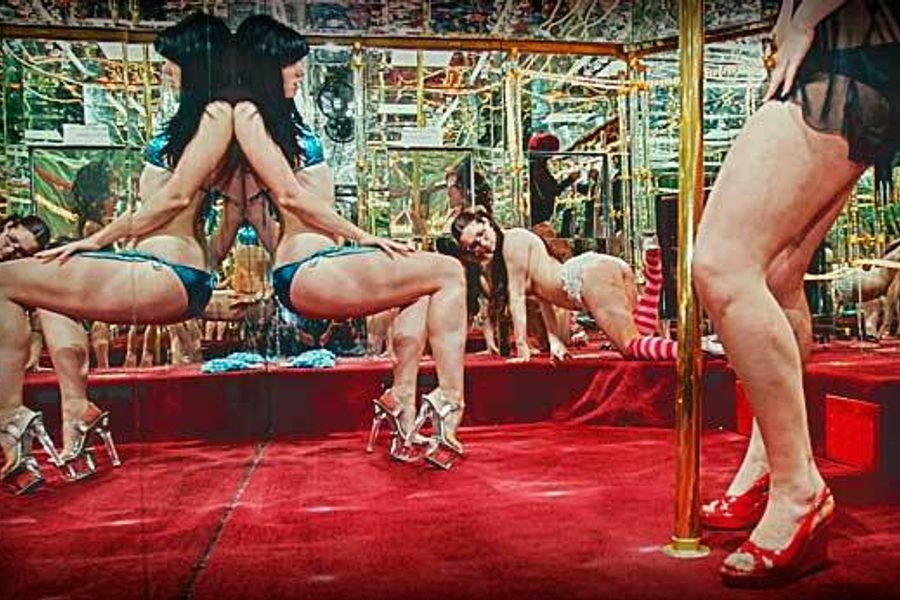The last time I danced at a strip club in Manhattan, I paid an $80 “house fee” to work. I was shouted at for slouching in my seat and for eating my lunch at the wrong time, and I went home with $40 less than I’d arrived with. After working in this exploitative industry for many years, I wanted to organize to improve working conditions for strippers. But when I reached out to other activists who had been involved in campaigns to protect dancers’ rights, the overwhelming response I got was: “Don’t do it!”
They had a point.
When dancers at the Lusty Lady, a San Francisco peepshow, successfully unionized in 1997, they put strippers’ labor rights on the map. Third-wave feminists across the world rushed to hold up the Lusty Lady as proof that sex work doesn’t have to be exploitative. The unionization drive and subsequent transition of the club into a worker-owned cooperative was seen by many as the start of a movement in which strippers would put a stop to the discriminatory practices that plague the industry.
Fifteen years later, the Lusty Lady remains the only unionized stripping venue in the country, and working conditions in most clubs have gotten worse, with dancers paying up to $300 a shift to work and often going home in debt to their employers. Meanwhile, dancers at the Lusty Lady have contracts and receive a standard wage instead of having to compete for tips. But rather than looking to the Lusty Lady as a beacon of progress, most strippers balk at the thought of working for an hourly wage instead of hustling for tips.
“I have never met anyone who lap-dances for any reason other than to make as much money in as little time as possible,” says Tempest, a dancer who was involved in the Lusty Lady union drive and now believes the effort may have been counterproductive. She poses a question that strippers can’t afford to ignore: “Is unionizing strip clubs conducive to making a profit?”
For most of my stripping career, I worked at a club in Queens, N.Y., that didn’t charge house fees. In 2008, when a new manager instituted a house fee, my coworkers and I wrote a letter asking management to stop charging the fee. Most of the dancers at the club signed it, so we figured we’d be safe – they couldn’t fire all of us, right? Of course, the owner turned out to be smarter than we’d thought: He retaliated by banning us from selling lap-dances, thus taking away our primary means of making money.
War broke out between the dancers who had signed the letter and those who hadn’t, with the latter accusing us of being bad at our jobs and ruining the club for the girls who knew how to make money. Many dancers, including those who had signed the letter, left to work at clubs that charged higher house fees but offered the freedom to hustle and sell dances. “If you didn’t want to pay the house fee, get another job!” one dancer screamed at me.
She didn’t need to yell for long. A few weeks later, the owner fired me and another dancer, whom he took to be the instigators, and re-introduced the house fee. I was left feeling that those who had warned me against organizing in strip clubs were right: Most strippers are willing to tolerate labor violations in exchange for the relative freedom to pursue quick cash in an unregulated environment.
Who wants to be an employee?
Tempest says that the Lusty Lady unionization drive made things worse for dancers on a wider scale by discouraging club owners from classifying dancers as employees. “In a sense, what we said to club owners when we organized was ‘If you make us employees, empower us, and give us better working conditions, we can – and probably will – use it against you.’ To potential club owners, what happened at the Lusty Lady could easily be seen as an example of what not to do.”
Whether or not the industry-wide shift toward classifying dancers as independent contractors was a result of fear of Lusty Lady-style unionization, it has certainly made it more difficult for dancers to organize for labor rights. By law, independent contractors are unable to unionize. More insidiously, dancers’ endless competition for tips undermines the worker solidarity necessary for any sort of workplace organizing.
But while independent contractor status has delivered a major setback to the strippers’ rights movement, dancers have not given up – they have merely shifted the battle site to courts. Ever since club owners figured out they could make more money by classifying dancers as independent contractors and charging them house fees, dancers across the country have been challenging the legality of this practice by filing lawsuits against individual clubs, claiming that they are employees, not independent contractors, and as such should not be paying to work. Results of these lawsuits vary, but in the majority of cases, courts rule in favor of dancers, who are awarded compensation for the house fees they’ve paid out over the years, as well as the back wages to which they are entitled as employees.
As yet, these lawsuits haven’t led to widespread change in the strip club industry, but the cumulative effect may be beginning to force club owners to pay attention. In July 2009, a Massachusetts state court ruled in favor of a dancer named Lucienne Chaves, who filed a class action lawsuit against King Arthur’s Lounge in Chelsea, Mass., leading to a slew of dancers across the state filing similar lawsuits against other strip clubs. Clubs across the state then began voluntarily switching over to classifying strippers as employees in an attempt to limit potential damages.
But not all Massachusetts dancers are happy with the change. Writing in The Daily Caller, Pussy Per Se, a stripper who has danced in clubs across New England, says: “I was an independent contractor, working at half a dozen clubs, making good money. It was a perfect job for a single mom. I could arrange my schedule around my son’s, … I might work a single club for weeks, …. [o]r I might take a break to go on a road trip with another dancer, reaping the benefit of being ‘new girls’ at a distant club.” But as an employee, she writes, she has lost this freedom in exchange for the security of being a “wage slave.”
Pussy Per Se has a point, but she’s missing part of the picture. The last time I worked in a Manhattan club, I was not the only one regularly going home in debt; I was not even in the minority. Friends working in clubs across the city report similar stories of building up debt to the point that, when they finally have a good night, they end up paying most of it back to the club in the form of back-house fees.
You could argue that dancers couldn’t be making that little or they would have quit already, but getting a day job is not an option for everyone. Many strippers are undocumented immigrants; others have no formal qualifications or experience outside of the sex industry. For these women, losing money to the club three nights a week and then landing a decent customer and going home with $250 on the fourth night is better than nothing. Meanwhile, clubs collect their house fees from dancers and win every time.
Learning from the Lusty Lady
So, what to do with an industry in which none of us want to give up our independence, but the cost of independence is bleeding us dry? There may be a third way between unionization drives and lawsuits brought by individual strippers. I recently heard about a club in California that seems to be striking a balance between freedom and fair labor practices. Unsurprisingly, it is owned and run by two former dancers. Dancers at Ruby’s (club name changed at the request of sources) pay house fees like independent contractors. What makes them different from dancers at most clubs is that they are actually treated like independent contractors, which essentially means no schedules.
The idea of running a strip club where dancers can come and go as they please may sound like a logistical nightmare, but Ruby’s appears to be making it work. “Management comes up with incentives to encourage dancers to work at certain times,” says Megan, a dancer at Ruby’s. “If you schedule yourself ahead of time you pay $20 instead of $30. If they see there aren’t enough girls working, they text dancers to try to get more to come in.” Dancers and managers negotiate these rules together at regular meetings.
Unlike the Lusty Lady, the democratic style of management at Ruby’s is motivated by practicality, rather than idealism. The owners know that if they’re going to classify dancers as independent contractors, they need to treat them like independent contractors or risk getting sued. At one point, there was a threat of trouble when the management wanted dancers to work longer hours. “We said, ‘If you do that, we’re not going to come in at all,’ ” Megan says. Eventually they negotiated a deal so that dancers who work the whole shift pay a lower house fee. “The easiest way to get strippers to follow the rules is to have strippers make the rules,” Megan says.
After learning about Ruby’s, I began to wonder if dancers across the country should go to court to be treated as independent contractors, rather than suing to be paid like employees. It could be a compromise that is better for everyone. Then again, it’s hard to imagine the suits who run corporate chains like Penthouse sitting down with hundreds of dancers to collectively negotiate the rules on a regular basis.
When the Lusty Ladies got the stripper labor rights movement rolling in 1997, they had a vision of how things were going to go. Today, most dancers aren’t psyched for unionization, but they sure as hell aren’t psyched to maintain the status quo, either. Given the number of lawsuits that are popping up across the country, strip club owners would do well to take steps to address rampant levels of exploitation. If they don’t, they could find themselves being forced to change the way they do business – in ways that may not actually benefit the majority of dancers.





